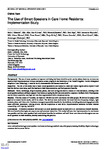The Use of Smart Speakers in Care Home Residents: Implementation Study
| dc.contributor.author | Edwards, KJ | |
| dc.contributor.author | Jones, RB | |
| dc.contributor.author | Shenton, D | |
| dc.contributor.author | Page, T | |
| dc.contributor.author | Maramba, I | |
| dc.contributor.author | Warren, A | |
| dc.contributor.author | Fraser, F | |
| dc.contributor.author | Križaj, T | |
| dc.contributor.author | Coombe, T | |
| dc.contributor.author | Cowls, H | |
| dc.contributor.author | Chatterjee, A | |
| dc.date.accessioned | 2022-02-08T16:53:52Z | |
| dc.date.issued | 2021-12-20 | |
| dc.identifier.issn | 1438-8871 | |
| dc.identifier.issn | 1438-8871 | |
| dc.identifier.other | ARTN e26767 | |
| dc.identifier.uri | http://hdl.handle.net/10026.1/18717 | |
| dc.description.abstract |
<sec> <title>BACKGROUND</title> The use of smart speakers to improve well-being had been trialed in social care by others; however, we were not aware of their implementation in most care homes across a region in the Southwest of the United Kingdom. For the widespread adoption of new technology, it must be locally demonstrable and become normalized. </sec> <sec> <title>OBJECTIVE</title> The aim of this study was to install smart speakers in care homes in a rural and coastal region and to explore if and how the devices were being used, the barriers to their implementation, and their potential benefits. </sec> <sec> <title>METHODS</title> Email, workshops, drop-in sessions, phone, and cold calling was used to contact all 230 care homes, offering a free smart speaker and some advisory support. Care homes accepting the devices were asked to complete a feedback diary. Nonresponse rate for diary completion was high and was thus supplemented with a telephone survey. </sec> <sec> <title>RESULTS</title> Over the course of 7 months, we installed 156 devices in 92 care homes for older people, 50 devices for people with physical or mental health needs, and 8 for others. The devices were used mainly for music but also for poetry, recipes, light controls, jokes, and video calls. Care home managers reported the benefits for the residents, including enhanced engagement with home activities, enjoyment, calming effects, and the acquisition of new skills. Implementation problems included internet connectivity, staff capacity, and skills. </sec> <sec> <title>CONCLUSIONS</title> Affordable consumer devices such as smart speakers should be installed in all care homes to benefit residents. Voice-activated technologies are easy to use and promote interaction. This study indicates that implementation in care homes was possible and that smart speakers had multifaceted benefits for residents and staff. Most care homes in this region now use smart speakers for their residents, thereby normalizing this practice. </sec> | |
| dc.format.extent | e26767-e26767 | |
| dc.format.medium | Electronic | |
| dc.language | en | |
| dc.language.iso | en | |
| dc.publisher | Journal of Medical Internet Research | |
| dc.subject | voice-activated technology | |
| dc.subject | smart speaker | |
| dc.subject | care home | |
| dc.subject | technology-enabled care | |
| dc.subject | older people | |
| dc.subject | learning disability | |
| dc.subject | digital technology | |
| dc.subject | consumer device | |
| dc.subject | smart device | |
| dc.title | The Use of Smart Speakers in Care Home Residents: Implementation Study | |
| dc.type | journal-article | |
| dc.type | Article | |
| plymouth.author-url | https://www.ncbi.nlm.nih.gov/pubmed/34932010 | |
| plymouth.issue | 12 | |
| plymouth.volume | 23 | |
| plymouth.publication-status | Published online | |
| plymouth.journal | Journal of Medical Internet Research | |
| dc.identifier.doi | 10.2196/26767 | |
| plymouth.organisational-group | /Plymouth | |
| plymouth.organisational-group | /Plymouth/Faculty of Health | |
| plymouth.organisational-group | /Plymouth/Faculty of Health/Peninsula Medical School | |
| plymouth.organisational-group | /Plymouth/Faculty of Health/School of Health Professions | |
| plymouth.organisational-group | /Plymouth/Faculty of Health/School of Nursing and Midwifery | |
| plymouth.organisational-group | /Plymouth/REF 2021 Researchers by UoA | |
| plymouth.organisational-group | /Plymouth/REF 2021 Researchers by UoA/UoA03 Allied Health Professions, Dentistry, Nursing and Pharmacy | |
| plymouth.organisational-group | /Plymouth/REF 2021 Researchers by UoA/UoA23 Education | |
| plymouth.organisational-group | /Plymouth/Research Groups | |
| plymouth.organisational-group | /Plymouth/Research Groups/Institute of Health and Community | |
| plymouth.organisational-group | /Plymouth/Research Groups/Plymouth Institute of Health and Care Research (PIHR) | |
| plymouth.organisational-group | /Plymouth/Users by role | |
| plymouth.organisational-group | /Plymouth/Users by role/Academics | |
| dc.publisher.place | Canada | |
| dcterms.dateAccepted | 2021-11-18 | |
| dc.rights.embargodate | 2022-2-12 | |
| dc.identifier.eissn | 1438-8871 | |
| dc.rights.embargoperiod | Not known | |
| rioxxterms.versionofrecord | 10.2196/26767 | |
| rioxxterms.licenseref.uri | http://www.rioxx.net/licenses/all-rights-reserved | |
| rioxxterms.licenseref.startdate | 2021-12-20 | |
| rioxxterms.type | Journal Article/Review | |
| plymouth.funder | E-Health Productivity & Innovation in Cornwall (EPIC2)::European Regional Development Fund |


